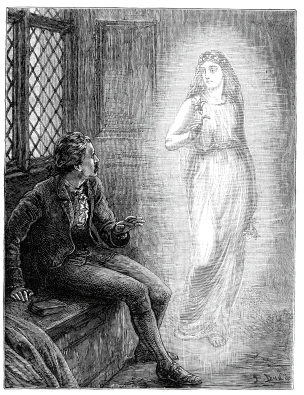Hello everyone,
The Ungrateful Dead is a finalist in the 2015 Aspen Gold Reader's Choice Contest! Winners to be announced in early October.
Below is the opening scene from The Ungrateful Dead, a novella that introduces Rick and Laura, a private-eye team who I like to call the "21st-century Nick and Nora" as they attempt to have a romantic weekend at a coroners' conference...that is, until there's a murder. Its sequel, The Zen Man, is a full-length mystery novel that continues the tale of Rick and Laura as they investigate another crime.
Click on the cover to your right to go to its Amazon page.
Excerpt: The Ungrateful Dead
“A Deadhead at a coroner’s conference,” said my date Laura, giving me a look over her martini. “That’s either too weird or too perfect.”
We stood in the crowded banquet room at the Independence Lode in Cripple Creek, Colorado. This hotel and casino was named after a gold mine that was discovered in eighteen-something by a grubstake miner whose find made him the richest man west of the Mississippi. People still trekked up to Cripple Creek with dreams of striking it rich at the casinos, although mostly they lost money while swilling free booze and trying to get laid. Not the ambiance I’d have picked for the Colorado Coroners Society’s annual conference, but then ex-junkie, suspended attorneys like me are the last people to pass judgments. Out loud, anyway.
The lights in the room had been turned down to create a moody atmosphere conducive to mindless chitchat, although it was difficult to imagine anyone in this crowd of coroners, morticians and cadaver groupies doing anything mindlessly. Especially chitchatting. Hell, it was difficult to imagine me attending a Dead gig unless the band was playing. But the CCS, the abbreviated moniker used by the coroner in-crowd, had offered me three nights in a froufrou Victorian B&B, all expenses paid, to speak about what to say, but more important what not to say, in court. Seemed some rural coroners had gotten loose-lipped and screwed up a DA’s ability to prosecute several key cases this past year, which made me a living-for-the-music Deadhead trying to teach a few courtroom tricks to the dying-is-a-living Deadheads.
“Yeah,” I finally answered. “It’s too perfect.”
I watched Laura’s lips--their color like dark, sweet cherries--pucker as she took a sip. Earlier, she’d told me that the lipstick color was called Burgundy Bistro, which had made me wonder if a chef was moonlighting as a copywriter for the make-up company. But it wouldn’t matter if she slicked on a color called Eggplant Eatery, it was what was underneath those luscious, supple lips that mattered. Lips I’d gotten to know well these past three months.
She swallowed, lowered her glass. “Did you ever tell me how that band got the name Grateful Dead?”
Laura’s sincere interest was a far cry from my ex-wife’s, whose hatred of the Dead bordered on the pathological. After I moved out, she took my original ’67 poster of the Dead at Whisky A-Go-Go in Los Angeles—a collector’s item probably worth several hundred dollars, but priceless to a Deadhead—and stuck it under her Lexus to catch leaking oil.
I like to think of myself as a forgiving kinda guy, but after discovering the plight of that poster I spent an entire week plotting my revenge, which mostly revolved around paying a tattoo-artist buddy to ink a Grateful Dead bear on her sorry ass after one of her too-much-box-wine nights. But eventually I let it go. Well, except for referring to her thereafter as Wicked—short for Wicked Wench of the West—but otherwise, I let it go. Already had enough karma on my plate, plus it would’ve been a waste of good ink.
I responded to Laura’s question. “It has something to do with the soul of a dead person being grateful to the charitable person who arranged their burial. Although more likely, Jerry was stoned outta his gourd and it sounded cool.” I took a swig of my root beer.
Laura laughed, making me feel taller and funnier.
Across the room, a blur of movement snagged my attention. A woman slouched in the doorway, backlit from the lights in the hallway. Couldn’t make out her features, but I’d recognize that mop of blond curls anywhere. The way she dragged her hand through those coils, periodically tugging one as though trying to straighten it, meant she was either pissed-off or nervous. I’d seen her wear that first emotion a lot.
“Good evening, everyone,” announced a woman’s voice over the speakers.
The chattering and clinking dropped several decibels.
“This is Dr. Susan Kebler. I invite you to direct your attention to the podium at the front of the room and welcome Mr. Kevin Voight, Executive Director of the Aspen Community Medical Foundation, who will be announcing this year’s recipient of the Forensic DNA Research Grant.”
A smattering of applause. At the podium there was some fumbling, followed by static thumping noises.
“Is this on?” asked a male voice.
“Turn up the lights,” someone yelled.
Overhead fluorescents popped to life, their stark light leeching the room of its party atmosphere. At the podium stood a man I presumed was Kevin Voight, pushing forty, dressed in a summer linen suit that set off his seamless tan.
“He looks familiar,” I murmured to Laura.
“Probably because he looks like Tom Cruise.”
“Really? Ask me, Tom’s a bit past his sell-by date.”
She flashed me a jealous-are-we? look, which I pretended not to see.
Truth was, yeah, Kevin had that Tom Cruise thing going for him. Although after Kevin-Tom started talking, I realized movie-star looks can only take a dude with no personality so far. Kevin came across like a robot. Stiff and in dire need of some inflection when he spoke. On and on he went in that relentless tone, acknowledging anybody and everybody who’d ever set foot on the planet. Finally, he gave the award to the Colorado Association of Clinical Something-somethings.
Afterward, Laura and I mingled and made small-talk with several coroners I hoped wouldn’t see either of us again for a long, long time. When she and I were alone I typically did most of the talking, but put us at a social gathering and Laura morphed into an expert schmoozer, a skill I chalked up to her years as an executive at TeleForce, a telecommunications giant based in Denver. She’d once tried to explain to me exactly what she did, but my brain had liquefied when she started talking about technology infrastructure and scalable architecture. Laura had the brains of a geek underneath her wild-girl rocker Grace Slick looks, the way Slick looked in her ultra-cool Jefferson Starship days when she had raven hair and wore dramatic eye make-up.
Although sometimes Laura’s left eye squinted slightly, as though she were scrutinizing something you’d just said. Minor nerve damage, she’d once explained, the result of a teenage motorcycle accident.
Several root beers and an assortment of canapés later, I heard a buzz in the room. People were whispering fervently, sharing some piece of news. And from their closed, tight looks, it was bad news.
An athletic, fiftyish woman with short-cropped gray hair nudged her way past me. As she paused to sneeze, holding a tissue to her nose, I read her name tag. Dr. Susan Kebler, Coroner, Teller County. The county for Cripple Creek, the site of this conference. Tucking the tissue into her pocket, she crossed the room to a grim-looking cop, who briskly led her away.
I caught snatches of conversations around me.
“…on the premises…”
A snorting laugh. “Live by the sword, die by the sword.”
“Where’s his wife?”
The cell phone in my shirt pocket vibrated. I checked the unfamiliar caller ID, figured it might be a new client.
“Levine Investigations,” I answered.
“Natalie.”
She’d always exaggerated her a’s—a Connecticut thing, she’d said—so whenever she said her name it sounded like a traffic jam of vowels butting up against consonants.
I glanced at the doorway where I’d seen her, but she’d split.
“I think I’m in trouble,” Natalie continued.
Through the phone, I heard background noise. Sirens. People yelling.
“Can you come to the construction area behind the casino?” she asked. “Police just arrived.”
Thoughts T-boned in my mind. Cops? Natalie was obviously free to make calls, so how much trouble could she be in? On the other hand, she was the last person who’d want to call me unless she really needed my help.
“Be right there.” I ended the call and glanced at my watch. Twenty to ten.
Laura’s brow furrowed. “What’s up?”
“Not sure.” I looked around, noticed others were migrating toward the exit, punching numbers into their cells. “How ‘bout I meet you back at our room?”
I took her by the elbow and guided her toward the exit. As we passed a tray, she drained the last sip of her martini and set the empty glass on it.
“Think it’s something I can’t handle?” Laura asked.
“Maybe.”
“Gruesome?”
I flashed on the cop’s stony expression as he spoke to Dr. Kebler. “Probably.”
Laura halted, her wide-set blue eyes boring into mine. “If I was game enough to join you for a romantic weekend at a coroner’s conference,” she whispered huskily, “I’m game enough for whatever’s in store.”
Gruesome had never been so alluring.
“Laura,” I murmured, trying not to let her I’m-game look override my better sense, “I don’t doubt you’re strong enough to handle many things, but I’m guessing there’s a body. A dead one.”
She rolled her eyes. “I worked at a nursing home the summer after high school. I’ve seen dead bodies before.”
“Yeah, aging ones succumbing to natural causes.”
“Dead is dead.”
“True, but I’m guessing this is more like ugly dead, something a lady like you shouldn’t see.” I gave her my best tough-guy-with-a-heart smile. The kind Tom Cruise wished he could give, and one I wished I felt.
Truth was, I didn’t know if I could handle the reality of what lay out there. Not the sight of a corpse—I’d seen photographs of dozens over the course of my criminal defense career—but the harrowing reminder of what death demands from the living.
The truth.
I’d failed to seek that that in the Willard case.
Of course, only a stupid defense attorney actually asks a client for the truth, as in did he or she do the dirty deed. You don’t want to hear your client say he killed the victim because your role is to fight for your client’s rights, win the best deal, hell if you play it right your client walks away as if he’d never committed the most egregious, heinous act possible to another human being. I still remembered watching Willard damn near skip down those courthouse steps, flashing a cocky grin that chilled me to my marrow…because at that moment I knew I’d helped free a killer…
I barely felt Laura’s arm as she wove it through mine and steered us toward whatever lay ahead.














